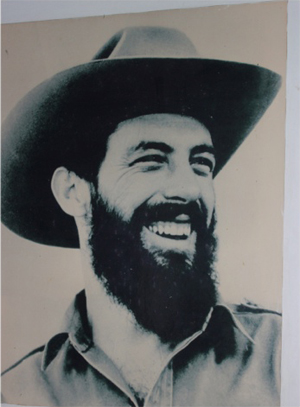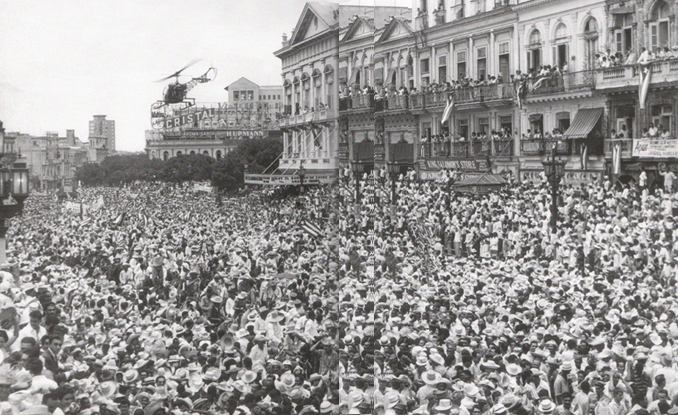Written by: Dr. Dushka H. Saiyid
Posted on: August 29, 2013 |  | 中文
| 中文
Moncada army barracks
The story of the revolution is a familiar one: an inept and corrupt dictatorship, supported by the USA, which allowed unrestrained exploitation by American companies of the country’s resources and its people. The majority of its 6 million population consisting of peasants, lived in grinding poverty, while the middle classes and the Americans lived a life of luxury. By the mid-1950s, Cuba had acquired a reputation as the “whorehouse of the Caribbean,” where Americans would come to gamble and carouse with Havana’s prostitutes. Not surprisingly, at one stage the storyline of the film, Godfather Part II, focuses on the American mafia’s business interests in Cuba.
Fulgencio Batista was a man of mixed race, great cunning and no scruples. After an army officers’ coup in 1933, he became chief of staff of the army, and was elected President in 1940, but lost the elections of 1944. He cut a deal with the Mafia before the elections of 1952: he would give them carte blanche in Cuba, in return for a cut of their gambling profits. Three months before the scheduled elections, which he appeared likely to lose, Batista carried out a military coup, supported and recognized by the US government, and condemned by all the opposition in Cuba. The ground was laid for revolution.
 |
| Camilo Cienfuegos, a leader of the revolution |
Fidel Castro was a young charismatic lawyer, a nationalist in the tradition of José Martí, with great oratorical skills. He was due to stand for elections, but when they were cancelled, he decided that only force could bring about a desperately needed change in the political and social system of Cuba. Fidel led 119 rebels in a badly planned attack on the strategically important Moncada army barracks in Santiago de Cuba on 26 July 1953. Sixty-four rebels were arrested, tortured and executed; Fidel and a handful, including his brother Raul, escaped to the mountains, only to be arrested a few days later. During his trial in full media glare, Fidel made his masterly speech, “History will absolve me”, which later became his political manifesto. He was sentenced to 15 years in jail, but when Batista granted amnesty to all political prisoners in 1955 in order to appease the opposition, Fidel was released and fled to Mexico.
Castro carefully laid plans for the invasion of Cuba with an armed band of guerrillas, raising funds and training them in Mexico. Che Guevara, an Argentinian doctor, joined his ranks, and was the only communist of the 82 who set sail for Cuba on November 25, 1956, in an old leisure yacht called Granma. Their landing on December 2 was disastrous; they were spotted by Batista’s forces and routed. Only about a dozen escaped to the hills of Sierra Maestra; but luckily, Fidel, Raul and Che were among the survivors, and thus began the tale of a handful of idealistic revolutionaries, fighting to rescue their country from the clutches of a depraved despot. Over the next few months they were sustained not only by the sympathetic peasantry, but the underground movement in the cities of Cuba, called the movement of July 26. Its leader in Santiago was Frank País, a 22 year old student. Slowly but steadily this rag tag bunch in the Sierra expanded their numbers, became seasoned fighters, and their attacks on Batista’s troops increased. When Herbert Mathews of the New York Times interviewed Castro in Sierra Maestra in February of 1957, it was a media coup that raised Castro’s international profile.
While Castro kept up the skirmishes against Batista’s troops in the Sierra, the political situation was reaching a boiling point in the rest of the country. In March 1957, José Antonio Echeverría, an opposition leader, led an attack on the Presidential Palace to assassinate Batista. Most of the 35 attackers were students, and only 3 survived. In September of the same year, there was an armed revolt by the naval officers, in the normally calm city of Cienfuegos. It was brutally crushed, but Batista’s hold on power was beginning to look tenuous. Although Frank País was killed in July in Santiago, but the underground movement was too well entrenched by now.
By early 1958 the tide was beginning to turn in favour of Castro who had established his headquarters in La Plata and was broadcasting propaganda on Radio Rebelde across Cuba. When Batista made a final bid for ending Fidel’s free run in the Sierra by sending 10,000 troops in May, their advance was halted with the help of the local peasantry. Castro signed the Caracas Pact with eight leading opposition groups, who called on the USA to stop all aid to Batista. Bolstered by the Caracas Pact, Castro was now on the offensive, and sent the charismatic Camilo Cienfuegos and Che Guevara west, to open new fronts in the Escambray Mountains. While Cienfuegos tied down troops in Yaguajay, Che sealed the victory by an audacious attack on an armored train in Santa Clara. Cienfuegos and Che advanced onto Havana on New Year’s Eve, while Batista made good his escape to the Dominican Republic in the early hours of January 1, 1958. Castro gave a victory speech in Parque Céspedes in Santiago on the same day, and then led a victorious cavalcade across Cuba to Havana. It felt like all of Cuba had come out on the streets to celebrate the liberation from the death squads and torture cells of Batista.
 |
| People celebrate the liberation of Cuba in Havana |
Extracts from the documentary, 'La Vida del Che'
Click to view picture gallery
You may also like: